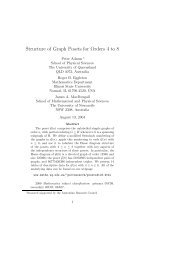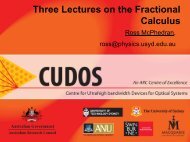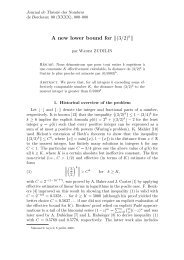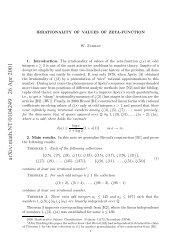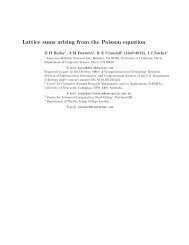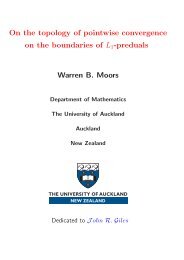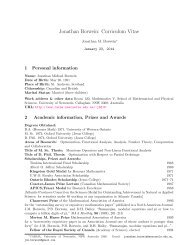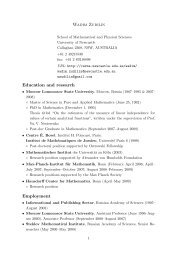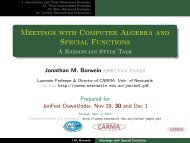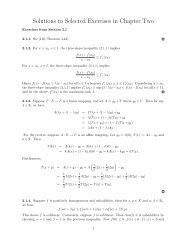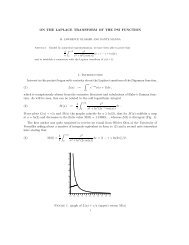QUADRATIC CONVERGENCE OF THE TANH-SINH ...
QUADRATIC CONVERGENCE OF THE TANH-SINH ...
QUADRATIC CONVERGENCE OF THE TANH-SINH ...
Create successful ePaper yourself
Turn your PDF publications into a flip-book with our unique Google optimized e-Paper software.
16 JONATHAN M. BORWEIN AND LINGYUN YEAlso, the evaluation of e 2 and e 3 involves the careful estimation of∞∑ ∞∑ e −r2 h 21 − erf(rh)erf(nh)n=a r=bHere we will not give further analysis. For any other quadrature rules with similarproperties, the similar approach can be taken.7. Numerical Convergence and ExamplesWe conclude with a few numerical illustrations and a brief discussion of theoptimality of the coefficient of the infinite trapezoidal rule.7.1. Numerical results. We exhibit results for the following set of test functions,earlier studied in [5]:(1) ∫ 1t log(1 + t) dt = 1/40(2) ∫ 10 t2 arctan t dt = (π − 2 + 2 log 2)/12(3) ∫ π/2(4) ∫ 10e t cos t dt = (e π/2 − 1)/20arctan( √ 2+t 2 )(1+t 2 ) √ dt = 2+t 2 5π2 /96(5) ∫ 1 √0 t log t dt = −4/9(6) ∫ 1 √0 1 − t2 dt = π/4(7) ∫ 10√t√1−t 2 dt = 2√ πΓ(3/4)/Γ(1/4) = β(1/2, 3/4)/2(8) ∫ 10 log2 t dt = 2(9) ∫ π/2(10) ∫ π/20(11) ∫ ∞0(12) ∫ ∞0(13) ∫ ∞log(cos t) dt = −π log(2)/20√ √tan t dt = π 2/211+t 2 dt = π/2e −t√tdt = √ πe −t2 /2 dt = √ π/20(14) ∫ ∞e −t cos t dt = 1/20Note that the first four of these integrals involve well-behaved continuous functionson finite intervals. The integrands in problems 5 and 6 have an infinitederivative at an endpoint. In 7 through 10, there is an integrable singularity atan endpoint. In 11 through 13, the interval of integration is infinite, requiring atransformation such as s = 1/(t + 1). Problem 14 is an oscillatory function on aninfinite interval.Table 1 gives the actual error resulting from using the summation (1.2) as anapproximation to the specified integral, rounded to the nearest power of ten. Theprecision used in these calculations was 1000 digits, so no results are shown witherrors less than 10 −1000 . The “level” shown in the table is an index of the intervalh, according to the rule h = 2 −m , where m is the level. In other words, at eachsuccessive level, the interval h is halved.It can be seen from the results in the table that the tanh-sinh scheme achievesapproximately exponential convergence, in the sense that the number of correctdigits approximately doubles with each level. In some cases, such as Problems 3, 5and 8, the convergence is slightly better than a doubling with each level; in othercases, such as Problems 12, 13 and 14, the rate is slightly less. It is remarkable thatProblems 1, 6, 7, 9 and 10 exhibit virtually identical convergence behavior.



